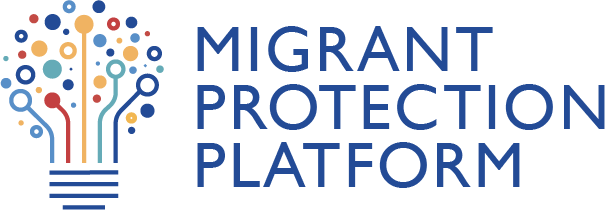PLAN OF ACTION
One of the pillars of IOM’s approach to protection is data, research, and learning. The approach acknowledges that the production of actionable research, knowledge, information, and statistics is one way that IOM directly contributes to the global evidence base for policy and programming to protect and uphold migrants’ rights.
The plan of action is guided by and seeks to further embed IOM’s Migration Data Strategy, Monitoring and Evaluation Strategy, Migration Data Governance Policy and Data Protection Principles, as well as other relevant internal guidance, such as IOM’s Principles for Humanitarian Action and its Rights-Based Approach to Programming, to ensure principled and responsible data management within IOM.
Protection work in this area is also underpinned by the Global Compact for Safe, Orderly and Regular Migration (GCM), which calls for collection and utilization of “accurate and disaggregated data as a basis for evidence-based policies” in its first objective. The need for reliable migration data is further referenced throughout the GCM, including for “effective monitoring and evaluation of the implementation of commitments over time.” Similarly, the Transforming our World: the 2030 Agenda for Sustainable Development (2030 Agenda) highlights the importance of quality and timely disaggregated data to guide decision-making and help measure progress.
Through the Plan of Action, the goal is to strengthen the global evidence base for policy and programming to address needs, protect, and uphold rights in the context of migration and displacement. IOM pursues this goal through four strategic pillars:
- Pillar I: Knowledge Production Strategic Objective
-
Strategic Objective: To produce actionable knowledge and research to inform policies and programming that account for and respond to the identified needs of migrants and their communities.
Action 1.1: Produce rigorous, policy-relevant research on rights and protection issues in the context of migration and displacement.
Action 1.2: Leverage IOM and partners’ administrative and operational data to strengthen the evidence base on rights and protection issues in the context of migration and displacement.
Action 1.3: Improve the availability of data on human rights and protection in the context of migration and displacement.
Action 1.4: Generate new, primary data and actionable statistics on rights and protection in the context of migration and displacement.
- Pillar II: Capacity Development
-
Strategic Objective: To develop the research, data management and analysis capacity of the international community, states, and other relevant partners to enhance the evidence base on rights and protection issues in the context of migration and displacement.
Action 2.1: Work with the UN statistical community to establish and build capacity on international statistical definitions and measurement frameworks for estimating the size of target populations, including to monitoring the progress of international targets and indicators, such as relevant Sustainable Development Goals and Global Compact on Migration Objectives.
Action 2.2: Build capacity to collect data on rights and protection needs in the context of migration and displacement safely and ethically.
Action 2.3: Develop modular survey tools that may be used by the international community to collect data on migrants with protection needs or whose rights may be at risk.
Action 2.4: Work with the UN statistical community to establish and build capacity on international standards for administrative data on migrants with protection and assistance needs.
Action 2.5: Support the establishment of data governance frameworks at the national, regional and global level, to govern the use of administrative data from a range of different stakeholders on rights and protection issues in the context of migration and displacement.
Action 2.6: Establishing standard frameworks and approaches for evaluation of policy and programming to protect and uphold rights in the context of migration and displacement.
- Pillar III: Learning and Utilization of New Evidence
-
Strategic Objective: To promote the uptake of new evidence by policymakers and practitioners to support them in protecting and upholding rights in the context of migration and displacement.
Action 3.1: Support and contribute to knowledge management initiatives related to data and evidence on rights and protection issues in the context of migration and displacement.
Action 3.2: Ensure coordination on data, information and analysis and knowledge exchange with other protection actors in the context of forced displacement.
Action 3.3: Foster an institutional culture of sharing and learning to strengthen seamless linkages between data and practice, ensuring that available evidence is systemically applied.
Action 3.4: Promote and strengthen the systematic use of best practices to gather, manage and analyse data and information to be used for protection emergency response.
Action 3.5: Foster cooperation and dialogue on data on rights and protection needs in the context of migration among states, international organizations, academia, and other stakeholders, to improve collection, management, sharing, and use, promote harmonization of data, and facilitate exchange of good practices.
Action 3.6: Ensure systematic engagement with and contribute to the relevant expert bodies on migration and displacement data.
- Pillar IV: Knowledge management systems and processes of Operational Data
-
Strategic Objective: To improve the quality, accessibility, analysis and utilization of knowledge management systems and protection operational data across IOM’s country, regional and Headquarter levels.
Action 4.1: Initiate, support and contribute to knowledge management initiatives related to data and evidence on rights and protection issues in the context of migration.
Action 4.2: Improve the safe accessibility, utilization and reach of knowledge and data management platforms located at global, regional, and national levels.
Action 4.3: Build staff capacity to conceptualize, commission, manage and comprehend data management, research and knowledge products.
Action 4.4: Provide quality assurance to all data management and research activities within the PXD.
FLAGSHIP PRODUCTS
- The Counter-Trafficking Data Collaborative (CTDC)
-
CTDC is the first global repository of primary case data on trafficking in persons.
- The International Classification Standard for administrative data on Trafficking in Persons (ICS-TIP) and guidance manual
-
Developed with UNODC, the ICS-TIP provides standardized definitions for classification variables of the trafficking in persons event, as well as disaggregating variables at the victim, perpetrator and reporting entity levels.
- The Human Trafficking Case Data Standard (HTCDS)
-
HTCDS is a global format and common approach to collecting and recording case data related to human trafficking. The GitHub page also provides a toolkit and a platform for discussion and feedback.
- The Human Trafficking Evidence Gap Map
-
Developed in collaboration with ILO under the Research to Action (RTA) project, the Human Trafficking Evidence Gap Map is an interactive tool that provides an overview of findings based on factors and outcomes associated with human trafficking. It is integrated with the Bibliography, and it will be updated as more relevant research becomes available.
KEY PLATFORMS
Access the key platforms and sources of raw data related to trafficking in persons, migration and displacement, where anonymized data can be accessed and freely downloaded for research and analysis.
- IOM Displacement Tracking Matrix (DTM)
-
The Displacement Tracking Matrix (DTM) gathers and analyzes data to disseminate critical multi layered information on the mobility, vulnerabilities, and needs of displaced and mobile populations that enables decision makers and responders to provide these populations with better context specific assistance.
- IOM’s Global Migration Data Analysis Centre (GMDAC)
- Other data sharing platforms in emergency settings

